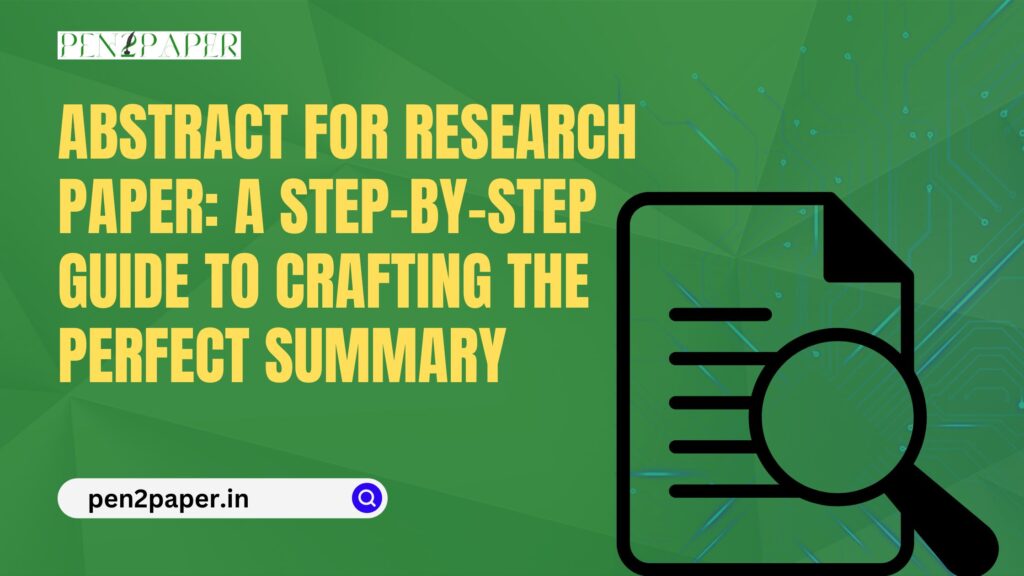An abstract for research paper serves as a concise summary of your study, providing a quick overview of the main points, methodology, results, and conclusions. It’s often the first thing readers encounter, making it critical to create a compelling and informative abstract that engages your audience and conveys the essence of your work. This blog post will guide you through a step-by-step process for crafting the perfect abstract for your research paper.

Why is the Abstract Important?
The abstract for research paper is a vital component because it:
- Gives readers a snapshot of your study.
- Helps them decide if the full paper is relevant to their interests or needs.
- Serves as a key element in search engine indexing, increasing the visibility of your work.
Now that we understand its importance, let’s dive into the steps for creating an exceptional abstract.
Step 1: Understand the Purpose of the Abstract
Before you begin writing, it’s essential to grasp the purpose of an abstract for research paper. An abstract should:
- Summarize the research question or objective.
- Briefly describe the methods used.
- Highlight the main findings or results.
- Conclude with the significance of the research.
Keep these elements in mind as we move through the writing process.
Step 2: Familiarize Yourself with the Structure
A well-written abstract for research paper typically follows a standard structure:
- Introduction: State the purpose or problem addressed by the research.
- Methods: Summarize the methodology used to conduct the study.
- Results: Highlight the key findings or outcomes.
- Conclusion: Explain the implications or significance of the results.
This structure ensures clarity and coherence, making it easier for readers to understand your work.
Step 3: Start with a Clear Research Question or Objective
Your abstract’s introduction should immediately address the research question or objective. Use precise language to articulate the problem or gap your study addresses. For example:
“This study examines the impact of digital learning tools on high school students’ academic performance, focusing on both quantitative and qualitative outcomes.”
Including the focus keyword abstract for research paper early in the introduction boosts its SEO value and sets the tone for the summary.
Step 4: Summarize the Methodology
The methodology section of the abstract for research paper should be concise yet informative. Avoid unnecessary technical jargon and focus on key details, such as the study design, sample size, and analytical techniques. For example:
“A mixed-methods approach was employed, involving a survey of 500 students and in-depth interviews with 50 educators. Data were analyzed using statistical software and thematic analysis.”
Step 5: Highlight the Results
When discussing results, focus on the most significant findings that align with your research objectives. Use quantitative data, where applicable, to enhance credibility. For example:
“The study revealed a 20% improvement in students’ test scores after implementing digital tools, with qualitative data highlighting increased engagement and motivation.”
Including the keyword abstract for research paper here reinforces its relevance and boosts SEO.
Step 6: Conclude with the Significance
The conclusion of the abstract for research paper should succinctly convey the implications of your findings. Avoid introducing new information; instead, summarize the study’s contribution to the field. For instance:
“These findings suggest that integrating digital learning tools into high school curricula can significantly enhance academic performance, providing a roadmap for future educational strategies.”
Step 7: Revise for Clarity and Conciseness
An abstract is typically limited to 150-250 words, so every sentence must count. After drafting your abstract for research paper, revise it to:
- Eliminate redundant words or phrases.
- Ensure it flows logically.
- Maintain a professional and objective tone.
Step 8: Optimize for SEO
To make your abstract for research paper more discoverable, incorporate the focus keyword strategically:
- Include it in the title.
- Use it naturally in the first 10% of the text.
- Repeat it 11 times throughout the content, ensuring it doesn’t feel forced.
- Add it to subheadings and body text where relevant.
Step 9: Common Mistakes to Avoid
While crafting an abstract for research paper, avoid these common pitfalls:
- Exceeding the Word Limit: Stay within the specified range to maintain clarity.
- Overloading with Details: Focus on the main points; leave intricate details for the main paper.
- Using Jargon: Write in a way that’s accessible to a broad audience.
- Failing to Proofread: Errors can undermine the professionalism of your abstract.
Step 10: Check Against the Checklist
Before finalizing your abstract for research paper, ensure it meets the following criteria:
- Clearly states the research question or objective.
- Summarizes the methodology effectively.
- Highlights significant results.
- Concludes with the study’s importance.
- Includes the focus keyword 11 times without overstuffing.
Conclusion
Writing an effective abstract for research paper requires a balance of clarity, conciseness, and relevance. By following this step-by-step guide, you can craft a summary that not only captures the essence of your research but also boosts its discoverability online. A well-written abstract ensures your work stands out and reaches the intended audience, maximizing its impact in the academic community.
